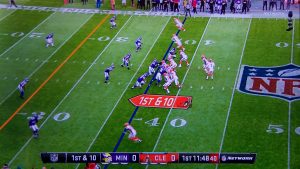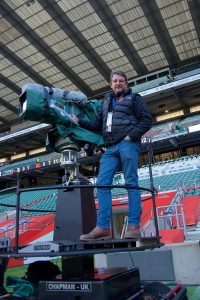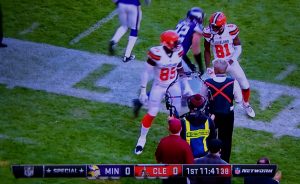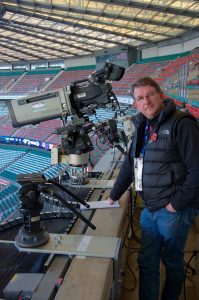Live from Twickenham: CTV helps NFL gain international traction with London games
American football has been making a play for more European viewers for ten years now, basing two games, initially, in London, rising to three, and this year playing four in the UK capital for the first time – two each at Wembley and Twickenham. The international host broadcast US operations were instigated by Ken Aagaard of CBS and Michael Davies of Fox Sports, and each broadcaster took charge of two of this year’s games – the last of which took place in Twickenham Stadium on Sunday between the Minnesota Vikings and the Cleveland Browns.
The NFL is also considering basing a franchise for a season in London — probably at the new home of Tottenham Hotspur, the Premiership soccer team, currently under construction, which is being designed to offer a broadcast infrastructure suitable for NFL games.
“NFL, as a strategic game, is difficult to fathom for the uninitiated,” explained Bill Morris, Chief Operating Officer, CTV Outside Broadcasts and Technical Manager for the NFL games. Where traditional European field sports (such as rugby or soccer) are “fairly straightforward adversarial games”, he likens NFL to “a combative game of chess – because it is all about strategy and about plays, and the unfolding of those quite complex pre-ordained plays to outwit your opponent.”

NFL uses much more graphics than the major European sports – as with these virtual 1st and 10 lines added by SMT
He sees part of its attraction as being a very friendly, family-inclusive day compared to an 80- or 90-minute rugby or soccer match. “The game unfolds over three-and-a-half hours, but it is also a very commercial game. Its relationship with TV is entirely interlinked in terms of the plays and the timing of everything, and the commercial content of the game as well, but that means the viewer doesn’t miss anything at all.
“From that point of view, I think, like no other sport, it can not be separated from television. It is completely embedded in television and television is completely embedded in the game.”
High level coverage
“Because of the strategic nature of NFL […] the camera positions tend to be higher than those, for instance, for rugby, and slightly higher than those for soccer,” although because of the design of most soccer stadiums, creating a higher camera position isn’t always possible, he said.
To allow higher positions at Twickenham, CTV designed custom camera mounts that sit securely, without drilling, on the parapet of the highest tier, 50 feet (15.25m) above the usual camera positions for rugby. These custom mounts were also used by the individual teams for their own cameras, as they also have an extensive TV operation (with cameras covering the end zones and the 50 – or half-way line – on both sides of the field).
CTV also provided other NFL-specific mounts, such as the cart that runs the sideline. “It is a Chapman

Bill Morris on the elevating Chapman Olympian dolly, which runs the sideline and is the only one in Europe
Olympian dolly – the only one in Europe,” imported especially ten years ago, and is pretty much used only on NFL. The 15-feet/4.5m elevating dolly allows a tight lens to be in line with the play.
It also uses many slo-mo cameras. “With the advent of the Sony 4300, we’ve been able to choose which cameras can be super motion cameras with relatively little change. That’s given directors and producers the versatility to not have to make decisions months in advance about the assets they are going to have on site as every 4300 has the ability to be a super slo-mo camera.”
Graphically speaking
NFL is a very graphics-heavy sport. Besides the first and ten lines – superimposed as the play progresses down the field, to show the distance the teams need to make – there is also a wide range of analysis and data-driven graphics (including individual player form, history and team stats). “There are stories within stories unfolding all the time,” shown through the graphics.
“Similarly, there is quite a large amount of commercial content, using graphics, in terms of replays and bumpers, and it is a lot heavier, in terms of commercial breaks, than any European sport. Every play, whether it be 20 or 30 seconds or a minute, will, more often than not, be followed by a commercial break,” said Morris.
CTV had to supply a large trailer unit just for graphics, housing two teams from the US: SMT (Sports Media Technology), for the virtual graphic content; and a host broadcaster team providing player and team information, statistics, and on-screen content.
“We’d normally have up to three Chyron or Viz machines providing the font stats and other graphic content. They are linked via IP to the broadcast centre in the States, where the graphic content can be updated throughout the game.”
Similarly, its large EVS network is linked via IP to the US, for studio analysis and content updates. This involved seven XT3s at Twickenham, used in 8-channel mode. “Each operator has at least two controllers and access to all channels for both ingest and replay. The super motion and replay content of the show is heavier than most European sport – because there are far more plays in NFL than there are in soccer or rugby, and the plays tend to be shorter, at the end of which we tend to roll in analysis and commercial based bumpers.”
NFL Network
The presentation needs at Twickenham were heavier than a normal league game. “Usually the game is one of many taking place that day, therefore we tend to come on air between one hour and half an hour before the game. The announcers are always in the announce booth (or commentary box), and they will do pre-game build up analysis. We then go to the game, and there will be a short period of post-game analysis. Then we take the press conferences, which which are usually not live to the host broadcaster, but are available online or on affiliates local to each team.”
Its first Twickenham game last year was for NFL Network, which is more presentation-based, with more of a talent presence around the game, and again at the 85,000-seater stadium this year it had a presentation platform to cover the pre-game tailgate party (in the car park), in the fan zone, plus pre-game presentation on field and in the announce booth. “Compared to a Thursday Night Football or a Super Bowl, it’s not as much presentation, but in terms of the stadium presence it is very similar, except we don’t have the usual NFL Network set on the field. And with TNF there is more pre- and post-game analysis,” said Morris.
A lot of the NFLN game is produced in the US, for which CTV provide mux feeds. “We send five switched camera feeds via IP,” so that the game, talent and analysis cameras “are available to be cut simultaneously for NFL Network shows, in real time,” with a producer in Twickenham making pre-selections from the multiple cameras, EVS and cut feeds as to which to include in the mux.
Its camera selection included an RF roving camera for pre-game colour and in-game coverage, dedicated talent cameras, handheld cameras on each sideline, a Jimmy Jib for team entrances, a Spidercam (having used Skycam for the games at Wembley), and robotic cameras on each of the goalposts – perched on the crossbar, with all the cabling Gaffer-taped bright yellow to match the posts.
All the long-lens cameras have 100:1 lenses for both close action play and close ups of the coach’s discussions with the players. “You see a lot of strategic conversations going on in the sideline team zones, and in the huddles on field. Everything comes from the coaches, who have comprehensive closed circuit team communications.”

The clear parabolic microphones are used to obtain visceral audio effects from the heart of the NFL action
On-field sound is captured using parabolic microphones. Although the concept has been around for more than a century, they are rarely used in sports coverage. “The technology is actually very simple. It is a very good way of hearing not just the spoken word, but also all those close effects that you get from a contact sport.” CTV uses two RF units running each sideline, pointing at the action, under instruction from the sub-mixer in the announce booth, who is mixing all the effects mics. The one-metre parabolics can be up to 50-75m from the action and still get the effects, despite being in a particularly loud environment. “It is a very narrow acquisition beam, so it is quite good at acquiring sound to the exclusion of the general ambiance,” he explained.
Besides supplying facilities for the host broadcaster, CTV facilitates the NFL, including integrated team comms, instant replay and analysis that each team has, plus international feeds. CTV also looks after the domestic (UK) broadcaster – either Sky Sports or the BBC (they alternate), which tend to have five or six of their own cameras for presentation and coverage, and their own graphic content.
Both do their own on field presentation (Sky uses its Sky Cart) and have studios at the stadium, usually linking back to their main studios – although Sky has recently started to use its stadium studio to also link direct to games from the US.
CTV supplies the support equipment to allow the teams to use their own equipment, wherever possible, usually requiring cabling and mounts (the European mounts are not the mounts they are used to – particularly the stadium Camseats).
“British stadiums simply don’t have the level of permanent integration that’s required for the NFL,” said Morris. “In fact, the NFL has taken big steps to upgrade the stadiums to a level where it is a little bit more plug and play than it used to be. Wembley, for instance, has gone through a big upgrade.
“WBL Services (Bill Lipscomb), which provides facilities for the NFL, has put a lot of its own integration into both Wembley and here [Twickenham] and will in Tottenham in the future,” mostly in terms of cabling. “Point-to-point fibre cabling is key, because at the moment if we go into a new stadium, there is a lot of home run cabling that needs to be installed. Labour equals cost, and the idea is to make NFL as straight-forward as possible in British venues.”
Both NFL and the Premier League have been involved with the design and integration at Tottenham, and the extensive NFL infrastructure should have benefits for soccer too, offering a wider range of facilities and camera positions than a normal soccer stadium.
Switched on: CTV OB11
CTV used its flagship truck, OB11, built two years ago, which mostly does UHD cricket for Sky Sports. It has a SAM Kahuna — “a very, very powerful switcher, [but] not very familiar yet in the US,” which is why CTV supplies a Kahuna engineer to sit with the technical director/vision mixer, who typically takes a day and a half to become acquainted with it. “Certainly over the past few games they have embraced it and made it sing,” said Morris.
“With NFL, we will fill a switcher more than any European sport,” and the truck’s 600×1056 Axon Cerebrum router was about at 60% capacity, mostly because of the very large amount of graphic content. The TD sets up far more macros and controls of other equipment than would be needed for a soccer or rugby game, due to the substantial amount of replay, VR and graphic content.
Because certain commercial graphics/messages can’t be used in certain territories, CTV has to trigger

CTV had to custom make parapet camera mounts for Twickenham, so that NFL could use higher camera angles, said Morris
different replays and switcher functions in other international broadcaster’s trucks. “Because the game is so fast moving, and there are so many replays, sometimes we have to link trucks using GPIs to trigger simultaneous replay transitions with alternative content,” he explained.
One unusual thing with OB11 is its windows. “Trucks have always been quite dark and claustrophobic, because you don’t want daylight on your monitor stack,” but it can isolate users, so offering multiple windows (with internal blinds) helps create a more pleasant atmosphere.
The trailer is also distinctive thanks to its triple-width exoskeleton design (by Neil Wilson), with both an outer shell and an inner section expanding from the core central equipment hub, to provide a lot more room. “The mechanics of OB11 are mind boggling. It has over 120 actuators, so as it opens and closes you have different facets of the truck moving at different angles,” said Morris. The design keeps the weight over the centre and reduces any movement of cables, and CTV plans to build another truck next year along the same lines.
“OB11 represents about as large as you can go with one truck.” European OBs tend to be about 3m shorter than US broadcasters are used to, “therefore we have to make up that space as creatively as we can with width, which we do, but it makes for very complicated mechanics.”
It also has a lot of other features to make it more user friendly, from leather and wood-covered walls, to the ability to electronically raise and lower work surfaces and move monitor stacks, and IP-integrated audio monitoring allowing individual users more control.
IP integration
OB11 is fully IP-capable, and can work as a remote engineering hub. “We think that IP will become the way that all outside broadcasts are made, with common shared galleries in regional strategic centres with numerous engineering hubs at the remote sports, so that one production team can deal with multiple sports in a day,” said Morris. “It is unlikely that entertainment and music production will go that way as fast as sport, because IP does lend itself best to sport, and we’ve done a few operations now with that technology – using OB11 and our other units.”
For the NFL, it simply uses IP for internal distribution and transmission (over fibre – with a satellite link for redundancy). It also recently did an experiment on NFL with Skycam being operated remotely via IP from New York (although, for safety, it had a pilot and crew at Wembley), which worked well, with minimal delay.
For Twickenham, it had four main host transmission paths to the US, plus multiple IP mux feeds. While NFL Network would probably prefer if every single source was available in the US, practical considerations mean that it has to have a producer selecting five individual cut feeds from any camera or other source.
The NFL coverage is in HD, but “there is no real barrier as to why it couldn’t be done in UHD. We would have to think outside the box in terms of inputs and outputs. It’s the I/O of the truck that is the key consideration. This is a big show, and UHD requires more-or-less four times the I/O, so it would need some thought. There is no reason why NFL shouldn’t go HD HDR, and I’m fairly convinced it will,” he said.
“HDR is the new big story, and we are currently shooting music and comedy shows in UHD HDR,” but it has done very little sport in HDR, although it is running training courses in HDR for its own staff and external production managers.
HDR monitoring is expensive, but one HDR monitor in the production area, another in vision and a third for executive viewing should be enough. There is no need to fixate on the colour space of your pictures, as composition is the priority. Given the expense of HDR monitors, “you have to prioritise where HDR is best viewed. That is not the entire monitor stack yet,” said Morris. “One generation from now, in terms of truck evolution, you may well see full HDR monitoring in a truck.”
